Related Research Articles

Celery is a marshland plant in the family Apiaceae that has been cultivated as a vegetable since antiquity. Celery has a long fibrous stalk tapering into leaves. Depending on location and cultivar, either its stalks, leaves or hypocotyl are eaten and used in cooking. Celery seed powder is used as a spice.

Ham is pork from a leg cut that has been preserved by wet or dry curing, with or without smoking. As a processed meat, the term "ham" includes both whole cuts of meat and ones that have been mechanically formed.
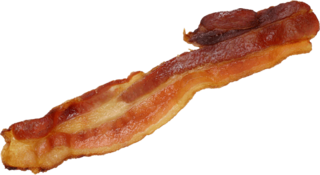
Bacon is a type of salt-cured pork made from various cuts, typically the belly or less fatty parts of the back. It is eaten as a side dish, used as a central ingredient (e.g., the bacon, lettuce, and tomato sandwich, or as a flavouring or accent.
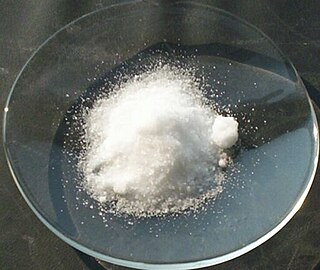
Potassium nitrate is a chemical compound with the chemical formula KNO
3. It is an ionic salt of potassium ions K+ and nitrate ions NO3−, and is therefore an alkali metal nitrate. It occurs in nature as a mineral, niter (or nitre in the UK). It is a source of nitrogen, and nitrogen was named after niter. Potassium nitrate is one of several nitrogen-containing compounds collectively referred to as saltpetre (or saltpeter in North America).

Braunschweiger is a type of sausage. The type of sausage the term refers to varies by region. In the German language, Braunschweiger is the demonym for people from Brunswick, but under German food law refers to a variety of mettwurst. In Austria, Braunschweiger is known as a type of parboiled sausage (Brühwurst), while American Braunschweiger is often confused with liverwurst.

Salami is a cured sausage consisting of fermented and air-dried meat, typically pork. Historically, salami was popular among Southern, Eastern, and Central European peasants because it can be stored at room temperature for up to 40 days once cut, supplementing a potentially meager or inconsistent supply of fresh meat. Countries and regions across Europe make their own traditional varieties of salami.

Biltong is a form of dried, cured meat that originated in Southern African countries. Various types of meat are used to produce it, ranging from beef to game meats such as ostrich or kudu. The cut may also vary, either fillets of meat cut into strips following the grain of the muscle, or flat pieces sliced across the grain. It is related to beef jerky in that they are both spiced, dried meats; however, the typical ingredients, taste and production processes may differ.

The nitrite ion has the chemical formula NO−
2. Nitrite is widely used throughout chemical and pharmaceutical industries. The nitrite anion is a pervasive intermediate in the nitrogen cycle in nature. The name nitrite can also refer to organic compounds with the – ONO group, which are esters of nitrous acid.
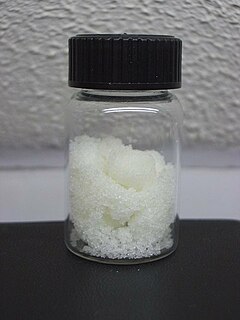
Sodium nitrite is an inorganic compound with the chemical formula NaNO2. It is a white to slightly yellowish crystalline powder that is very soluble in water and is hygroscopic. From an industrial perspective, it is the most important nitrite salt. It is a precursor to a variety of organic compounds, such as pharmaceuticals, dyes, and pesticides, but it is probably best known as a food additive used in processed meats and (in some countries) in fish products.

Pancetta is a salt-cured pork belly salume. In Italy, it is often used to add depth to soups and pastas.

Processed meat is considered to be any meat which has been modified in order to either improve its taste or to extend its shelf life. Methods of meat processing include salting, curing, fermentation, smoking, and/or the addition of chemical preservatives. Processed meat is usually composed of pork or beef, but also poultry, while it can also contain offal or meat by-products such as blood. Processed meat products include bacon, ham, sausages, salami, corned beef, jerky, hot dogs, lunch meat, canned meat, chicken nuggets, and meat-based sauces. Meat processing includes all the processes that change fresh meat with the exception of simple mechanical processes such as cutting, grinding or mixing.

The origins of meat preservation are lost to the ages but probably began when humans began to realize the preservative value of salt. Sausage making originally developed as a means to preserve and transport meat. Primitive societies learned that dried berries and spices could be added to dried meat. The procedure of stuffing meat into casings remains basically the same today, but sausage recipes have been greatly refined and sausage making has become a highly respected culinary art.

Charcuterie is a French term for a branch of cooking devoted to prepared meat products, such as bacon, ham, sausage, terrines, galantines, ballotines, pâtés, and confit, primarily from pork.
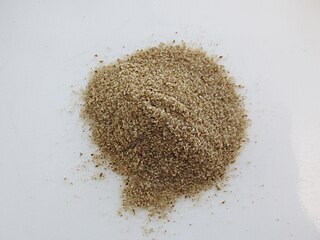
Celery salt is a seasoned salt used to flavour food. The primary ingredient is table salt and the flavouring agent is ground seeds from celery or its relative lovage. It is also sometimes produced using dried celery or seed oleoresin.

Onion powder is dehydrated, ground onion that is commonly used as a seasoning. It is a common ingredient in seasoned salt and spice mixes, such as beau monde seasoning. Some varieties are prepared using toasted onion. White, yellow and red onions may be used. Onion powder is a commercially prepared food product that has several culinary uses. Onion powder can also be homemade.
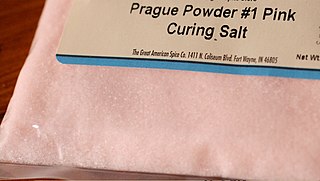
Curing salt is used in meat processing to generate a pinkish shade and to extend shelf life. It is both a color agent and a means to facilitate food preservation as it prevents or slows spoilage by bacteria or fungus. Curing salts are generally a mixture of sodium chloride and sodium nitrite, and are used for pickling meats as part of the process to make sausage or cured meat such as ham, bacon, pastrami, corned beef, etc. Though it has been suggested that the reason for using nitrite-containing curing salt is to prevent botulism, a 2018 study by the British Meat Producers Association determined that legally permitted levels of nitrite have no effect on the growth of the Clostridium botulinum bacteria that causes botulism, in line with the UK’s Advisory Committee on the Microbiological Safety of Food opinion that nitrites are not required to prevent C. botulinum growth and extend shelf life..
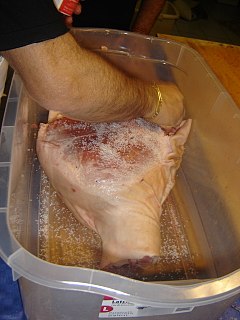
Curing is any of various food preservation and flavoring processes of foods such as meat, fish and vegetables, by the addition of salt, with the aim of drawing moisture out of the food by the process of osmosis. Because curing increases the solute concentration in the food and hence decreases its water potential, the food becomes inhospitable for the microbe growth that causes food spoilage. Curing can be traced back to antiquity, and was the primary method of preserving meat and fish until the late-19th century. Dehydration was the earliest form of food curing. Many curing processes also involve smoking, spicing, cooking, or the addition of combinations of sugar, nitrate, and nitrite.

Cured fish is fish which has been cured by subjecting it to fermentation, pickling, smoking, or some combination of these before it is eaten. These food preservation processes can include adding salt, nitrates, nitrite or sugar, can involve smoking and flavoring the fish, and may include cooking it. The earliest form of curing fish was dehydration. Other methods, such as smoking fish or salt-curing also go back for thousands of years. The term "cure" is derived from the Latin curare, meaning to take care of. It was first recorded in reference to fish in 1743.
A low sodium diet is a diet that includes no more than 1,500 to 2,400 mg of sodium per day.
References
- 1 2 3 Tarté, Rodrigo (2009-02-21). Ingredients in Meat Products: Properties, Functionality and Applications. pp. 398–399. ISBN 9780387713274.
- 1 2 3 Doyle, Michael P.; Sperber, William H. (2009-09-23). Compendium of the Microbiological Spoilage of Foods and Beverages. p. 78. ISBN 9781441908261.
- ↑ Encyclopedia of Meat Sciences: 3-volume set. 2014-07-22. p. 451. ISBN 9780123847348.
- ↑ Schwarcz, Joe (20 March 2017). "Is celery juice a viable alternative to nitrites in cured meats?". Office for Science and Society. McGill University. Retrieved 12 November 2018.
- ↑ Neuman, William (July 1, 2011). "What's Inside the Bun?". The New York Times . Retrieved 5 January 2015.
- ↑ Tanya Zuckerbrot, MS, RD. "The Truth About Bacon". Fox News Magazine. Archived from the original on 6 January 2015. Retrieved 6 January 2015.
{{cite web}}: CS1 maint: multiple names: authors list (link)